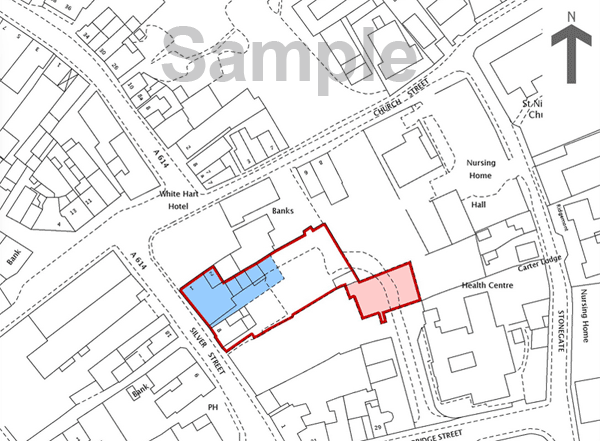Land Registry Search
A Land Registry search is a means to obtain a copy of documents held by the Land Registry in return for a small fee. These documents, the Title Register and Title Plan, identify the property and provide details of ownership and the terms upon which it is held.
This article describes what the Land Registry is, what it does, and how it came into being. It then goes on to describe the main documents held by the Land Registry, what they are used for, and how to obtain them.
Contents
HM Land Registry
The Land Registry, or rather, giving them their full title, HM Land Registry, are an autonomous government body that have the responsibility of maintaining a record of property ownership in England and Wales. In practice they do much more than this, and pride themselves (and with good reason) as being the paragon of excellence in global Land Registration.
Land Registry records are now held digitally and copies of the primary registration documents can be obtained speedily and whenever required.
HM Land Registry's website can be accessed directly here.
Origin of the Land Registry
The Land Registry originated during the reign of Queen Victoria, in 1862, with the introduction of the Land Registration Act. At that time, however, being a voluntary system of land registration, it was utterly ineffective, and did not rise to any degree of prominence until 1951 when the phasing in, across England and Wales, of compulsory registration began. It was not until December 1990 that those areas which had not already been phased in, all became subject to compulsory registration.
At that time compulsory registration only applied to certain dispositions, i.e. the sale or mortgage of a legal estate in property. Those events where known as registration "triggers".

Old Land Registry Building. Now part of the London School of Economics and Political Sciences
Land Registration Trigger Events
Compulsory registration triggers have been extended, and will continue to do so as Land Registration grows. The current registration triggers briefly comprise:
- Estates in Land, i.e.
- Sale or Gift of a Fee Simple Absolute in Possession (a freehold property)
- Sale or Gift of a Term of Years Absolute (a leasehold property) where the term is for more than 7 years, or where more than 7 years of an existing term remains.
- Discontinuous leases having a total of more than 7 years in possession.
- Profits a Prendre in Gross, e.g. Fishing Rights.
- Rentcharges, i.e. annual charges made by a freeholder to the owners of a lease.
- Franchises
Land Registry Documents of Title
The documents of Title comprise:
- Title Register
- Title Plan
- Lease with attached Lease Plan (if the property is Leasehold)
When selling a property, up to date copies of these documents are always required by your solicitors or conveyancers.
Other Documents obtainable from HM Land Registry
- Prior Copies of the Title Register
- Associated Documents including any attached Deed Plans
- Bankruptcy Searches
- List of Properties owned by a Company or other non-individual organisation
- List of Charges owned by a Company or other non-individual organisation
- Index Map Certificates
- Pending Applications for Registration
- Caution Titles
- Caution Title Plans
Title Register
The Title Register is one of the two main documents of Title. After the introductory information (Title Number, Land Registry office dealing with the property, date, etc) It is divided into three sections, named as follows:
- A Property Register
- B Proprietorship Register
- C Charges Register
A Property Register
The Property Register describes the property by using its address, where there is one, and by referring to the illustrated description of it in the Title Plan. The tenure of the property is shown, i.e. either freehold or leasehold and the date of first registration. Where the tenure is leasehold a brief description of the lease is provided (original parties, date of creation and length of lease). Easements are also set out in the A section.
B Proprietorship Register
This section provides details of ownership, i.e. the name and contact addresses of the owner, the class of title owned by him, restrictions on his dealings with the property, purchase price, date of purchase and personal covenants (binding on him only, not on subsequent purchasers).
C Charges Register
The C section sets out charges, restrictive covenants and other burdens affecting the property.
Title Plan
The Title Plan is prepared by the Land Registry at the following scales:
- Urban Areas - scale of 1:1250
- Rural Areas - scale of 2:500
- Remote Rural Areas - scale of either 1:5000 or 1:10000, depending on how remote the property is.
The property is identified as that lying within the area outlined in red. Parcels of land that are subject to rights of way, covenants, wayleaves, etc, will usually be coloured for identification purposes. The meaning of the colouring is provided in the Title Register. This is one of the reasons it is recommended to obtain both the Title Register and the Title Plan, rather than one of them alone.
Nearby properties are also frequently shown, to help identify the property location.

Lease
Leasehold properties are created by Lease. They are usually very lengthy documents and provide considerable detail relating to the various covenants governing ownership. The lease also describes shared areas, or common parts. Almost always, the Lease is accompanied by an attached Lease Plan, often providing invaluable information relating to car parking spaces, bin stores and garden areas.
Title Register
The Land Registry Title Register holds data relating to the property ownership, purchase price, mortgage, tenure, covenants, rights of way, leases and class of title.
£19.95Title Plan
The Title Plan shows an outline of the property and its immediate neighbourhood, and uses colours to identify rights of way, general boundaries and land affected by covenants.
£19.95Lease & Lease Plans
The Lease and its Lease Plan usually form one document and are both provided for the one fee. They are very useful in resolving disputes, particularly with car parking and other shared areas.
£19.95


